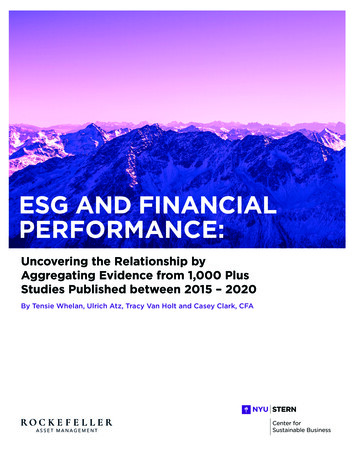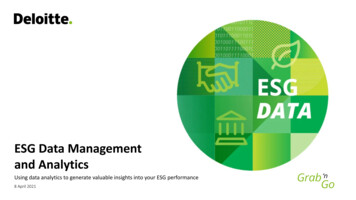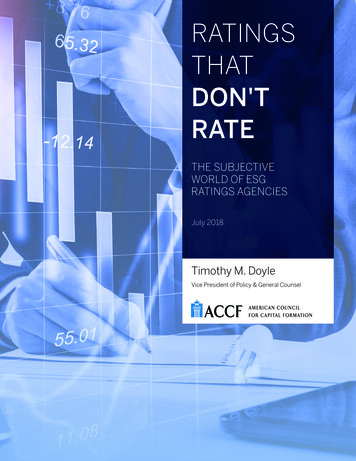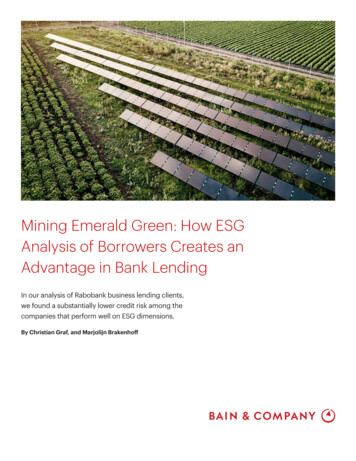
Transcription
ESG AND FINANCIALPERFORMANCE:Uncovering the Relationship byAggregating Evidence from 1,000 PlusStudies Published between 2015 – 2020By Tensie Whelan, Ulrich Atz, Tracy Van Holt and Casey Clark, CFA
Executive SummaryMeta-studies examining the relationship between ESG and financial performance have a decades-longhistory. Almost all the articles they cover, however, were written before 2015. Those analyses found positivecorrelations between ESG performance and operational efficiencies, stock performance and lower cost ofcapital. Five years later, we have seen an exponential growth in ESG and impact investing – due in largepart to increasing evidence that business strategy focused on material ESG issues is synonymous with highquality management teams and improved returns. A case in point: A recent study looked at the initial stockmarket reaction to the COVID-19 crisis (up to March 23) and found that companies scoring high on a “crisisresponse” measure (based on Human Capital, Supply Chain, and Products and Services ESG sentiment) wereassociated with 1.4-2.7% higher stock returns (Cheema-Fox et al., 2020). Nevertheless, the topic continues tobe debated, with some arguing that companies and investors should stick to managing for stock price andthat ESG is, at best, a distraction from the real business of making money.The authors of this report, NYU Stern Center for Sustainable Business and Rockefeller Asset Management,collaborated to examine the relationship between ESG and financial performance in more than 1,000research papers from 2015 – 2020. Because of the varying research frameworks, metrics and definitions,we decided to take a different approach than previous meta-analyses. We divided the articles intothose focused on corporate financial performance (e.g. operating metrics such as ROE or ROA or stockperformance for a company or group of companies) and those focused on investment performance (fromthe perspective of an investor, generally measures of alpha or metrics such as the Sharpe ratio on a portfolioof stocks), to determine if there was a difference in the findings. We also separately reviewed papers andarticles focused on low carbon strategies tied to financial performance in order to understand financialperformance implications through the lens of a single thematic issue.We found a positive relationship between ESG and financial performance for 58% of the “corporate” studiesfocused on operational metrics such as ROE, ROA, or stock price with 13% showing neutral impact, 21%mixed results (the same study finding a positive, neutral or negative results) and only 8% showing a negativerelationship. For investment studies typically focused on risk-adjusted attributes such as alpha or the Sharperatio on a portfolio of stocks, 59% showed similar or better performance relative to conventional investmentapproaches while only 14% found negative results. We also found positive results when we reviewed 59climate change, or low carbon, studies related to financial performance. On the corporate side, 57% arrivedat a positive conclusion, 29% a neutral impact, 9% mixed and, 6% negative. Looking at investor studies, 65%showed positive or neutral performance compared to conventional investments with only 13% indicatingnegative findings. A detailed breakdown can be found in Figure 1.These findings were supported by an additional meta-meta-analysis (a study of existing meta-studies) weundertook. We found 13 corporate meta-analysis studies published (covering 1,272 unique studies) with aquantitative approach and 2 investor meta-analysis studies (covering 107 unique studies) published since2015. The former found consistent positive correlations between ESG and corporate financial performance;the latter found that ESG investing returns were generally indistinguishable from conventional investingreturns. (Figure 2). We concluded that these two findings are robust across time and space.2ESG and Financial Performance
We drew six conclusions aboutthe relationship between ESGand financial performance afterexamining the 1000 plusindividual studies.1.Improved financialperformance due to ESGbecomes more marked overlonger time horizons.2.ESG integration, broadlyspeaking as an investmentstrategy, seems to performbetter than negativescreening approaches. Arecently released RockefellerAsset Management studyfinds that ESG integrationwill increasingly bedemarcated between“Leaders” and “Improvers”with the latter showinguncorrelated alphaenhancing potential overthe long-term (Clark &Lalit, 2020).3.4.3ESG investing appearsto provide downsideprotection, especially duringa social or economic crisis.Sustainability initiativesat corporations appearto drive better financialperformance due tomediating factors such asimproved risk managementand more innovation.5.Studies indicate thatmanaging for a low carbonfuture improves financialperformance.6.ESG disclosure on its owndoes not drive financialperformance.ESG and Financial PerformanceResearch over the last five years appears to be producing moreconclusive results, but it is worth acknowledging the challengeswith inconsistent terminology, insufficient emphasis on “material”ESG issues, ESG data shortcomings, and confusion regardingdifferent ESG investing strategies. Research covering ESG and financial performance often suffersfrom inconsistent terminology and nomenclature. Meuer et al.(2019) found 33 definitions of corporate sustainability in usage.For corporations, embedded sustainability (ESG is part of thebusiness strategy) may have different performance implicationsthan traditional Corporate Social Responsibility (CSR) effortsthat emphasize community relations and philanthropy, yetthere has been insufficient review of those differences, creatingnoise in the findings (Douglas et al., 2017). We see some ofthat confusion in a study by Manchiraju and Rajgopal (2017)which assessed the (poor) financial performance of companiesrequired to spend 2% of their profits on CSR by the Indiangovernment. In this case, CSR was philanthropy and communityrelations, not sustainability related to the material ESG issuesthat could enhance long-term performance. Research often fails to distinguish between material andimmaterial ESG issues as well as ESG leaders versus improvers. Forexample, Khan et al. (2016) demonstrate the alpha potential whenincorporating “material” ESG issues, with the stock performanceof companies focused on material issues outperforming thosethat focuses on immaterial ESG issues or no ESG issues at all.Rockefeller Asset Management’s research shows similar results:one study emphasizes that ESG integration will increasingly bedemarcated between “Leaders” and “Improvers” and finds longterm alpha enhancing potential when focusing on material ESGissue improvement (Clark & Lalit, 2020). The results are also complicated by the lack of standardizationwith ESG data. Studies use different scores for differentcompanies by different data providers. Eccles et al. (2017), forexample, reviewed a global survey of institutional investors andconcluded that “the biggest barrier is the lack of high qualitydata about the performance of companies on their materialESG factors.” Plenty of technical evidence also points to theshortcomings of accounting metrics and ESG data (Berg etal., 2019). We found that at least 40% of studies relied on anoverall, third-party ESG score. ESG integration, ESG momentum, decarbonizing, sociallyresponsible investing (SRI), negative screening, and impactinvesting are just a few of the varied approaches referencedin the research. They are often merged together, even thougheach has different risk-reward implications. A common researchapproach is to query Bloomberg for funds labeled ESG – thosefunds are self-designated, and may lack a robust ESG investingframework. Studies can also confuse the outcome by failing todistinguish between performance of a strategy seeking marketrate or excess returns versus a strategy prioritizing positiveenvironmental and social impact while accepting concessionary
returns. Hernaus (2019) is an exception: she found that financial performance differed based on thesustainable investing strategy employed by European fund managers. She writes, “previous studies havepredominantly treated SRI as homogeneous (Schroeder, 2007; Rathner, 2013) and have not distinguishedbetween particular, different SRI strategies available, whose number and diversity (European SustainableInvestment Forum – Eurosif, 2012; US SIF, 2012; European Fund and Asset Management Association, 2016)reflect the great heterogeneity of this financial phenomenon (Sandberg et al., 2009).” Investors seemto be making a distinction; Eurosif found that ESG integration grew at a compound annual growth rate(CAGR) of 27%, while negative screening fell 3% (Eurosif, 2018).Some of the earlier short-comings in the corporate research have been addressed in the last five years,which may be why we have more clear positive findings. However, academic researchers continue to bechallenged by the variability of ESG data and the lack of distinction between different investment strategies,creating an opportunity for investors and researchers who can overcome this challenge. Judging from thefact that the volume of research produced since 2015 is comparable to all papers published before 2015, thisis clearly an area where we should expect to see increased and improved research in coming years.Figure 1. Positive and/or neutral results for investing in sustainability dominate. Very few studies found a negativecorrelation between ESG and financial performance (based on 245 studies published between 2016 and 2020) .58%57%Corporate (all)Corporate (climate change)Investor (all)Investor (climate ativeCorrelationMediationESG and Financial Performance22%8% 6%Climatechangeaction428%14% 13%PositiveNeutralFigure 2. Conceptual overview of how investing in sustainability/ESG drives financialperformance: We reviewed and categorized relevant academic studies and analyzedthem through correlations, mediating factors, and a specific theme – climate change.Sustainabilitystrategy& practice22%Corporate financialperformance(CFP) or marketperformanceMixedNegativeInvestor-focused studiestend to look at a directrelationship between ESGand performance based onbenchmarks and a portfoliolevel view of themes such asmateriality or governancestructure. Meta-analyticaleffects are Hedges’ g or d.Corporate-focused studiesmay include mediatingfactors such as innovation,operational efficiency, orrisk management for abetter understanding of howsustainability initiatives leadto CFP. Meta-analytical effectsare partial correlations fromregression models.
The Results Indicate anEncouraging Relationship betweenESG and Financial PerformanceIn reviewing over 1,000 studies published between2015 – 2020, we found a positive relationshipbetween ESG and financial performance for 58%of the “corporate” studies focused on operationalmetric such as ROE, ROA, or stock price with 13%showing neutral impact, 21% mixed results (the samestudy finding a positive, neutral or negative results)and only 8% showing a negative relationship. Forinvestment studies typically focused on risk-adjustedattributes such as alpha or the Sharpe ratio on aportfolio of stocks, 33% found positive performance26% found neutral impacts (in other words,performed similar to conventional investments), 28%had mixed results (positive, neutral, or negative,generally because they examined a variety ofvariables and time periods as well as multiplesamples in one study) and 14% found negativeresults. In other words, 59% showed similar or betterperformance relative to conventional investmentapproaches while only 14% found negative results.We also found positive results when we reviewed59 climate change, or low carbon, studies relatedto financial performance. On the corporate side,57% arrived at a positive conclusion, 29% a neutralimpact, 9% mixed and, 6% negative. Looking atinvestor studies, 65% showed positive or neutralperformance compared to conventional investmentswith only 13% indicating negative findings. A detailedbreakdown is found in Figure 1.These findings were supported by an additionalmeta-meta-analysis (a study of existing meta-studies)we undertook. We found 13 corporate meta-analysisstudies published (covering 1,272 unique studies) witha quantitative approach and 2 investor meta-analysisstudies (covering 107 unique studies) published since2015. The former found consistent positive correlationsbetween ESG and corporate financial performance;the latter found that ESG investing returns weregenerally indistinguishable from conventional investingreturns. (Figure 2). We concluded that these twofindings are robust across time and space.5ESG and Financial PerformanceMany of the studies reviewed described a findingand tried to explain it through the lens of a socialscience derived model of the world. Several socialscience theories dominate the research: Stakeholder theory (successful companies needto manage for a wide variety of stakeholderssuch as employees, civil society, suppliers andinvestors), Shared value (companies that create shared valuefor all stakeholders do better financially), Legitimacy theory (a social contract between thecorporation and society, which, if broken, leadsto consumers reducing demand or governmentsimposing regulatory restrictions), Resource-based view (emphasizing internalresources such as employees and intangible assetsfor achieving a competitive advantage).Studies most often invoked stakeholder theory(N 80), but shared value, legitimacy theory and theresource-based view appeared in a sizeable share ofstudies (16% - 25%).Notably, those studies that did not include a socialscience theory only found a one-in-three positiveassociation with ESG and financial performance,whereas the odds were one-in-two on average forresearch grounded in social science theories.This finding points toward the need to betterunderstand the mechanisms behind the relationshipbetween ESG and financial performance. Ioannouand Serafeim (2019) in Corporate Sustainability: AStrategy? took a closer look at whether sustainabilitymight be considered a strategic approach (leadingto a competitive advantage) or common practice(a set of standards within an industry that conferlegitimacy). They find that both options are relevantand that adoption of sustainability over time iscomplex and dynamic.
Figure 3. Twelve of thirteen meta-analyses (comprising 1,272 studies) found a positive association between some aspectsof sustainability and financial performance (1976-2018).Studyestimate95% confidence/credible intervalLopez-Arceiz et al. 20180.199[0.166, 0.232]Lu & Taylor 20160.174[0.145, 0.202]Hou et al. 20160.158[0.134, 0.182]Busch & Friede 20180.119[0.104, 0.134]Plewnia & Guenther 20170.094[0.062, 0.126]Gallardo-Vazquez et al. 20190.084[0.068, 0.100]Hang et al. 20190.072[0.060, 0.084]del Mar Miras-Rodgriguez et al. 20150.067[0.023, 0.111]Wang et al. 20160.059[0.045, 0.072]Vishwanathan et al. 20190.030[0.022, 0.038]Hoobler et al. 20180.023[0.007, 0.039]Jeong & Harrison 20170.007[0.001, 0.013]Rost & Ehrmann 20170.004[-0.004, 0.012]Modeled mean estimate0.089[0.053, 0.127]06ESG and Financial Performance0.24
Six Key Takeaways1. Improved financial performance due to ESGbecomes more marked over a longer time horizonWe found that our proxy for an implied long-termrelationship had a coefficient with a positive signthat is statistically significant. The model suggeststhat, everything else being constant, a study withan implied long-term focus is 76% more likelyto find a positive or neutral result. Hang et al.(2019) undertook a meta-analysis (N 142) whichfound corporate investments in environmentalsustainability had no effect on corporate financialperformance in the short term, but had positiveeffects over the longer-term. Some recent paperswere optimistic about how markets value longterm commitments. Kotsantonis et al. (2019) foundthat CEOs communication of “long-term plans”resulted in an abnormal positive reaction by thestock market. A cross-sectional study on firmswith strong ESG ratings found returns up to 3.8%higher per standard deviation of ESG score in themid- and long-term (Dorfleitner et al., 2018).2. ESG Integration as a strategy seems to performbetter than negative screening approachesand ESG momentum may cause improvers tooutperform leadersThe sample size of studies on specific portfoliomanagement strategies and asset classes wassmall, making it challenging to interpret how theywould translate into decision-making for an assetmanager. The dominant research approach wasto find a sample of sustainable funds or indicesand compare them to a conventional benchmark.Most of the research focused on equities (N 54,with 33% finding alpha, 54% finding a neutral ormixed effect) rather than fixed income (N 11, with19% finding alpha and 56% finding a neutral ormixed effect). In addition, most studies focusedon active (N 41, with 29% alpha and 56% neutralor mixed) vs passive (N 6) investing.We also looked at the explicit or implicitinvestment strategies that underpin the analysis7ESG and Financial Performancein the academic studies (they serve as proxyfor “real-world” applicability; for example,researchers may define a universe of availableESG funds or use an ESG score in a regressionmodel). We found ESG integration seemedto perform better than negative screeningand divesting, with 33% of the (N 17) studiesfinding alpha and 53% finding neutral or mixedresults. The subgroup of papers analyzingpooled investment strategies (combiningeverything with some type of ESG label) wasleast convincing in terms of showing a positiveassociation (65% less likely). We speculate itmight be because too many different strategieswere combined together. For example, thisgroup contains socially responsible investing(SRI) and ethical funds that may not have anambition to match or outperform a conventionalbenchmark. Ielasi et al. (2018) compareddifferent sustainable investing strategies witheach other and indeed found performancedifferences between passive and active andethical versus ESG integration strategies.Very few studies emphasized material ESGissues and demarcated between ESG Leaders,or best-in-class firms, and ESG Improvers,or firms showing the greatest improvementin their ESG footprint. One seminal papertitled Corporate Sustainability: First Evidenceon Materiality published in 2016 by Kahn,Serafeim and Yoon from Harvard BusinessSchool showed the outperforming potential ofmapping material ESG issues and emphasizingmomentum, or ESG improvement (Khan et al.,2016). Rockefeller Asset Management’s researchfurther supports these results. In their paper,ESG Improvers: An Alpha Enhancing Factor,they use materiality mapping to differentiatebetween ESG Leaders and ESG Improvers, anddemonstrate the alpha potential of the latter ina study covering US equities from 2010 – 2020.
The key takeaways from the research include: A back-tested, hypothetical portfolio of topquintile ESG Improvers outperformed bottomquintile ESG “Decliners” by 3.8% annualized inan analysis covering US all cap equities from2010 – 2020. The signal is monotonic, in thatoutperformance grew with each quintile. An optimized hypothetical ESG Improversportfolio, which seeks to isolate pure ESGimprovement while controlling for sector andfactor biases, generated 0.5% annualizedexcess returns from 2010 – 2020 with 1.3%tracking error relative to the Bloomberg US3000 Index. The ESG Improvers factor enhanced returnswhen integrated with traditional factorsover the back-test period. A hypotheticalmulti-factor ESG Improvers Quality LowVolatility portfolio outperformed a twofactor Quality and Low Volatility portfolio by0.45% annualized. Over the same time period,an ESG Improvers Value MomentumPortfolio outperformed a two-factor Value andMomentum portfolio by 1.1% annualized.3. ESG investing appears to provide downsideprotection, especially during social oreconomic crisisESG investing appears to provide asymmetricbenefits. As discussed below, investor studiesin particular seem to demonstrate a strongcorrelation between lower risk related tosustainability and better financial performance.Recent events have provided unique datasetsfor researchers. During the financial crisis(2007-2009) Fernández et al. (2019) foundthat German green mutual funds deliveredrisk-adjusted returns slightly better than theirpeers (during non-crisis they were equal toconventional funds, but better than SRI funds).Similarly, the FTSE4Good, a set of ESG stockmarket indices, performed better and recoveredits value quicker after the 2008 financial crash(Wu et al., 2017). These findings seem to hold ingeneral for economic downturns as high ratedESG mutual funds outperformed low rated fundsbased on the Sharpe ratio (Chatterjee, 2018; Daset al., 2018). Finally, in the first quarter of 2020COVID downturn, 24 of 26 ESG index fundsoutperformed their conventional counterparts,which they credited ESG leading to moreresiliency and at the end of the third quarter, 45%8ESG and Financial Performanceof ESG-focused funds outperformed their index(Morningstar, 2020). While virtually all studies,by academics and practitioners alike found thiscorrelation, one outlier, based on ESG scores, didnot find such a correlation (Demers et al., 2020)4. Sustainability initiatives at corporations appearto drive financial performance due to factorssuch as improved risk management and moreinnovationSustainability strategies implemented at thecorporate level can drive better financialperformance through mediating factors—i.e.the sustainability drivers of better financialperformance such as more innovation, higheroperational efficiency, better risk management,and others, as defined in the Return onSustainability Investment (ROSI) framework (Atzet al., 2019). We reviewed the studies through thelens of these mediating factors and found thatstakeholder relations, risk, operational efficiency,and innovation were the most common in theliterature. For example, Vishwanathan et al.(2019) reviewed 344 studies and identified fourmediating factors – enhancing firm reputation,increasing stakeholder reciprocation, mitigatingfirm risk, and strengthening innovation capacity –which drove financial performance.Our regression analysis reviewed 17 studies thatincluded some aspect of innovation in theiranalysis, and all had positive findings regardingrelated financial performance. However, someof these studies did not exclusively focus oninnovation and so the individual effect is hardto separate out. In addition, the small samplesize reduces the level of confidence; thus we seethis as an exciting area for further research. Foroperational efficiency, more than half of the 22studies (59%) found a positive correlation betweenoperational efficiency and financial performance;only three of the 22 had a negative finding.Regarding risk, we found that investor studiesthat did not include risk as a mediating factorwere only 27% likely to find a positive correlationwith financial performance, while 48% ofthose studies that did include risk were likelyto find a positive result. And 52% of the 40studies across all studies looking at risk founda positive correlation. For example, portfolioswith lower ESG risks can maintain risk-adjustedperformance (Hübel & Scholz, 2020). Gloßner(2018) concluded that controversial firms with
a known history of ESG incidents exhibit “afour-factor alpha of 3.5% per year, even whencontrolling for other risk factors, industries, orfirm characteristics.” In addition, with regards toclimate-change related risk, 51% of the studiesfound a positive correlation between betterfinancial performance and managing for physicaland transition risk related to climate change.Overall, no single mediating factor resulted in astatistically significant effect in our model; partlybecause the underlying samples are small andpartly because the effects are hard to isolatein studies that mostly look very broadly at therelationship between sustainability and financialperformance. More research is needed in this area.5. Studies indicate that managing for a low carbonfuture improves financial performanceResearch on mitigating climate changethrough decarbonization strategies is fairlyrecent, but finds strong evidence for betterfinancial performance for both corporates andinvestors. Unfortunately, none of the three elitefinance journals (Journal of Finance, Journal ofFinancial Economics, and Review of FinancialStudies) published a single article related toclimate change over their analysis period (DiazRainey et al., 2017; Zhang et al., 2019), whichwe corroborated. However, 59 studies on therelationship between low carbon strategies andfinancial performance were published elsewherein the last five years, and the majority uncovereda positive result. Mitigating risk was the focuson many of the studies, as discussed earlier. Forexample, Cheema-Fox et al. (2019) examinedthe construction of decarbonization factors andfound that different decarbonization strategiesgenerate different risk-adjusted returns. Inparticular, they found strategies that loweredcarbon emissions more aggressively performedbetter. In, Park, and Monk (2019) assessed 736US public firms from 2005 to 2015, and foundthat a strategy of going long on carbon efficientfirms and shorting carbon inefficient firms couldearn an annual abnormal return of 3.5%-5.4%.Their research indicates that investing in carbonefficient firms can be profitable even withoutgovernment incentives.Few studies focused on the investment9ESG and Financial Performanceimplications of investing in companies producingclimate mitigation or adaption solutions,which differs from decarbonizing portfolios.This is a promising area of research. It seemslikely that climate change will transformeconomies and markets through changingregulations, changing consumption patterns,especially from next generation consumers,and technological advancements. As a proofpoint, FTSE’s Opportunities All Share Index - anindex that includes companies with involvementin Renewable & Alternative Energy, EnergyEfficiency, Water Infrastructure and Technology,Waste Management & Technologies, PollutionControl, Environmental Support Services, andFood, Agriculture & Forestry – outperformed itstraditional counterpart, FTSE Global All Cap Indexby 4.9% annualized over the five-year period fromOctober 2015 – October 2020.6. ESG disclosure on its own does not drivefinancial performanceJust 26% of studies that focused on disclosurealone found a positive correlation with financialperformance compared to 53% for performancebased ESG measures (e.g. assessing a firm’sperformance on issues such as greenhousegas emission reductions). This result holds ina regression analysis that controls for severalfactors simultaneously. While what gets measureddoes matter, measuring ESG metrics without anaccompanying strategy seems ineffective. Forexample, signatories to the UN Principles forResponsible Investment agreed to implementESG policies, but the focus is on disclosure versusperformance and Kim and Yoon (2020) foundthat the signatories on average improved neitherthe ESG nor the financial performance of theirportfolios. In more general terms, Fatemi et al.(2018) specifically distinguished between ESGdisclosures and performance. While high (low)ESG performance increased (decreased) firmvalue, they also found that ESG disclosures ontheir own had a negative valuation effect.
ConclusionOur analysis of more than 1,000 research papersexploring the linkage between ESG and financialperformance since 2015 points to a growingconsensus that good corporate management ofESG issues typically results in improved operationalmetrics such as ROE, ROA, or stock price. Forinvestors seeking to construct portfolios thatgenerate alpha, some ESG strategies seem togenerate market rate or excess returns whencompared to conventional investment strategies,especially for long-term investors, and providedownside protection during economic or social crisis.Notably, very few studies found definitive negativecorrelations between ESG and financial performance.Unfortunately, studies to help us understand whythese correlations exist were lacking. There werevery limited studies on mediating factors such asinnovation and operational efficiencies that mightdrive better corporate performance. And mostinvestment studies did not clearly demarcate thediffering risk-reward outcomes of varying ESGintegration approaches, nor did they analyzethe different performance implications of ESGleaders (best-in-class firms) versus ESG improvers10ESG and Financial Performance(firms showing the greatest improvement in theirESG footprint). Finally, thematic studies are alsorelatively limited although climate change studiesshow promise; research shows a strong relationshipbetween decarbonization strategies and improvedperformance.Studies need to better distinguish between differenttypes of investment strategies and asset classes inorder to analyze financial performance. Thematicstudies on material issues such as climate changeprovide an intriguing approach as focusing on oneissue may lead to more conclusive results. We alsorecommend that future meta-analyses distinguishbetween corporate and investor studies as we havedone. Finally, an area that has been woefully underresearched is the causal factors for improved financialperformance by corporates with robust sustainabilitystrategies – we recommend more research intosustainability-driven innovation, employee relations,supplier loyalty, customer demand, risk mitigation,operational efficiency, and so on.We look forward to reviewing the field of theresearch in 2025!
Appendix:MethodologyTo understand differences in studies in a systematic manner,
These findings were supported by an additional meta-meta-analysis (a study of existing meta-studies) we undertook. We found 13 corporate meta-analysis studies published (covering 1,272 unique studies) with a quantitative approach and 2 investor meta-analysis studies (covering 107 unique studies) published since 2015.










